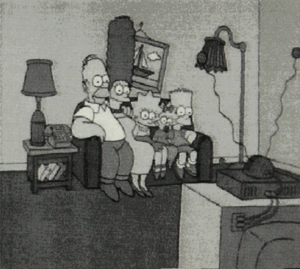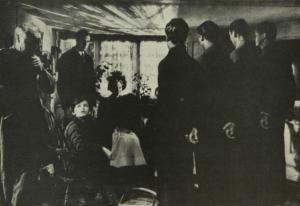Two significant media developments during the past ten years have created a need for media teachers to make a serious re-evaluation of the why, what and how of film education. The first development is the widespread acceptance and use of VCRs in the home and the consequent burgeoning of video movie hire outlets. A large number of students now have access to “R” films, films which censorship laws exclude from most classrooms.
While teachers may use Cujo (M) in senior classrooms to illustrate techniques of suspense and horror, junior and senior students may be watching Evil Dead (R) at a local youth camp or Porky’s (R) on the home video. It could be argued that if we given them the skills to evaluate films, this discrepancy will not matter. This view seems to be an unrealistic one. Adults and children alike respond to film on an emotional as well as intellectual level and unfortunately film criticism often either fails to legitimate an emotional response or demeans its relevance.
The second development is pertinent to a re-evaluation of how we acknowledge audience response in our courses. Film producers are now selling films in much the same way as advertising agencies produce a campaign for selling soap. Many producers talk about target audiences, phone surveys and public interest screenings – especially for that group under 25 which make up the majority of the film going public. Films have always been marketed but perhaps not with the same intensity or cynicism as was made apparent in “The Age” article ‘Selling Soft Core Porn Dreams to Teens’, 21st September, 1983. Here the most disturbing element seems to be the intent to market soft core porn films to teenagers using a formula that taps their emotional uncertainties and makes narrative incidental. Films such as Moving Out and Fighting Back are about teenagers not for them. The moral perspective in such films is clearly adult. Porky’s, Private School, Zapped, Losing it and their ilk, tap a need in teenagers not only to be entertained but also to satisfy their sexual curiosity, to be an adult, to have power, to be loved or admired. That is why these films are so commercially successful.
As a media teacher I have kept fairly close to the safety net of an intellectual approach to film: narrative structure, genre, authorship, themes and film technique. Analysis, however, almost by definition, tends to be a rather detached exercise and one which may not account for what happens in the minds of an audience.
Most of my teenage students have seen at least several of the teenie soft core porn films. Their reactions have included anger, embarrassment, arousal, excitement, amusement, curiosity and confusion, but rarely boredom. How can you be bored with sex education humorously presented, or a comedy that challenges adult moral authority and indulges teenage fantasies, especially those of boys? The difficulty in dealing with this film phenomena is to enable students to evaluate discerningly what they are watching and at the same time to consider the emotional level without being morally dogmatic.
Teaching the following unit on “Soft Core Porn for Teenagers” was one of my more rewarding teaching experiences. The rewards included a closer working relationship with the students because we had dealt with topics about which they had a personal concern. Girls had the opportunity to discuss their reactions to the rather unsympathetic depiction of females in these films and the lack of sympathy they felt boys in general sometimes exhibited. Many of the boys also seemed to gain some insight into, and sympathy for, the girls’ reactions to the films.
If you wish to teach such a unit there are probably a few ground rules to be observed:
• Concentrate on senior students so that you can use “M” rated films
• Make sure you know your students’ individual sensitivities and family backgrounds
• Make sure you understand the group dynamics in your class, for example, how the various male or female groups interact.
• Be prepared to speak openly and fairly about the films and their issues.
• Carefully preview all films in order to anticipate possible reactions or issues.
The unit as it is presented here seems quite analytic. There is no way that I can adequately account for the innumerable and crucial discussions I had with individual students and small groups.
Course Description
The unit was undertaken over a six-week period and involved approximately 20 hours of class time. The films were shown in order of least explicit to most explicit. This enabled me to gauge classroom reactions and decide when group discussion would be more profitable than general class discussion.
Objectives
The three main objectives are:
1. To encourage students to achieve an understanding of the ways in which soft core porn films for teenagers are devised to reach their intended market.
2. To encourage students to become critically aware of the implied values of such films.
3. To enable students to recognize and evaluate their own responses to such films.
Week 1
Introduction
A: Class Media Habits
Distribute copies of the amusements page from a newspaper printed during the previous holiday period.
Discuss: What is a “target audience”?
Attempt to identify the target audience for each of the films. How do the graphics assist you with this identification? Who appears to be the target audience for most of the films? Why? What is a “teenage movie”? How many students have seen each of the “teenage movies” either at the cinema or on video?
B. Reading and discussion of the article “Selling Soft Core Porn Dreams to Teens” (“The Age” 21st September, 1983). Key Question: What does the diary reveal about the INTENTIONS of the film makers and their strategies for achieving a successful market of the film?
C. Discuss Unit to be undertaken and reasons for doing it. Issue and discuss the final assignment in order to allow students to take relevant notes during film viewings.
Assignment
Select ONE of the following issues or themes to examine during the viewing of this series of films:
1. The ways in which females are presented in the films.
2. The ways in which males are presented in the films.
3. How realistically these films depict teenagers and teenage relationships.
4. The ways in which adults are presented in the films.
5. Sexual attitudes and values presented in the films.
6. A topic to be negotiated with the teacher.
Presentation of the work: Choose ONE of the following forms of presentation:
1. An essay of at least 500 words in which you discuss one of the above topics. (Individual work.)
2. A video taped review or interview concerning one of the above topics. (Group work.)
3. A radio or sound documentary, review or interview concerning one of the above topics. (Group work.)
All films must be referred to in whichever form of presentation is chosen.
D. Viewing of Zapped
General class discussion.
General discussion questions for all films
1. Is the central character male or female? Why?
2. What character type has been chosen for the main male character? Why?
3. What character type has been chosen for the main female character? Why?
4. What is stereotype? (e.g. Discuss the photographs on p. 134 of Media She, P. Edgar, which present role reversals and suggest how women may be stereotyped. Why are these photographs of males in cheesecake poses “ridiculous”?) What kinds of stereotypes do you find among the female teenage characters, the male teenage characters and the adult characters?
5. Why have these stereotypes been chosen? e.g. Why are adults depicted as childish or corrupt or sexually incompetent?
6. Which types of females expose their bodies? When? How? Why? Which types of females never expose their bodies?
7. Which types of males expose their bodies? When? How? Why? Which types of males never expose their bodies?
8. What are the differences between the ways in which male and female characters expose their bodies?
9. How realistically does the film present:
school life
home life/family life
society in general e.g. politics, access to money and good relationships between male and female, female and female, male and male?
10. Who are the winners and losers in the film? Why?
11. Whose side is the film on?
12. What is left out of the film, e.g. small children, why?
13. Is there any evidence of a marketing formula being applied to the film?
14. What kinds of reactions did students have to the film?
Sequence Analysis: (Examine shot by shot one school situation sequence from each film.) How are the characters presented? What do their actions in the sequence reveal about the film itself?
Week 2
Viewing of Losing it
Group discussion: Answer the above questions in groups. Report back to the class on the similarities and dissimilarities between the films viewed to date.
As a class discuss a sequence from the film.
Week 3
Viewing of Porky’s II
Group Discussion: As for Week 2.
As a class discuss the distinctive nature of the film, i.e. the almost unique presentation of male nudity and the use of a plot involving serious social issues such as racial prejudice.
Week 4
Viewing of Private School
Class discussion as for Week 1.
Group and class discussion: Compare the article from “The Age” on Private School with the film itself. Have the intentions of the producer, as suggested in the diary, been fulfilled? If so how?
Weeks 5 and 6
Assignment.





